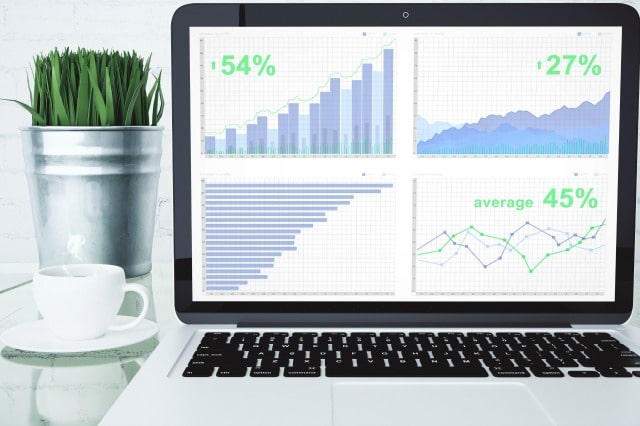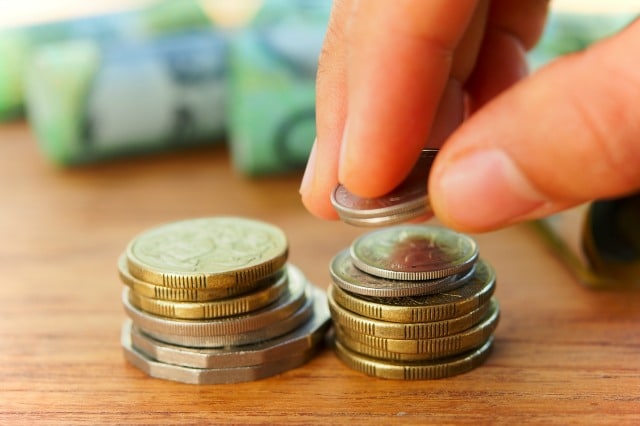The One Thing You Need To do To Stick To Your Budget
This website may earn commissions from purchases made through links in this post.

“If you design for the outcomes, you’re designing at the wrong place. You need to design for the behaviours that lead to the outcome… and most of the behaviours we need to do are habits.” – B J fogg TED Talk
If you want to manage your finances you create a budget, right?
That’s what everyone says:
Create a budget, track your expenses, live within your means.
Voila.
Easy, right?
Except it isn’t.
Because budgeting doesn’t actually work like that. A budget is a planning tool. If you use it right, it helps you to decide how you’re going to save money.
But it doesn’t save the money for you.
And tracking your expenses? That’s a handy little exercise if you want to analyse your spending patterns and get a grip on your spending habits. But it doesn’t save money for you either.
Which brings us to what really gets results… your everyday habits.
If you want to stick to your budget and save money, it’s your habits you should focus on. The savings follow.
Disclaimer: This is general information only. In this blog, I share my savings and budget planning and what works for us. You should always consult a qualified financial expert when making money decisions to tailor plans to suit your circumstances.
Just say your goal is to save $1,000.
That’s a great goal!
And just say you’ve made it “SMART”: you’re going to save $1,000 in 6 months.
What’s the next step?
Maybe you create a budget and work out how much you pay for all your expenses. And you reverse engineer your goal and work out that you need to save $166 each month to reach your goal.
And then what?
If you continue with your old spending patterns then…not much.
Because a budget is only good if you take action every day to stick to it.
For example, reducing your energy cost might require you to get into the habit of hanging your washing on the line every wash.
If you want to save money on lunches, you need to get into the habit of taking your lunch to work every day.
If you want to save money on groceries, you need to get into the habit of meal planning.
Our habits are foundational to the success of our financial goals.
The Power of Habits
“Your life today is essentially the sum of your habits.” – James Clear
According to studies, habits account for 40% of our behaviours each day.
That means almost half the things we do each day we do without thinking about it.
This is a good thing most of the time. Imagine if you had to concentrate every time you ate or brushed your teeth.
Habits save a heck of a lot of mental energy. But they do more than just save mental energy. What you do repeatedly forms the person that you are.
If you’re fit, for example, it’s because you have a regular habit of physical activity.
If you have savings in the bank, it’s because you have a regular habit of saving money.
Habits make otherwise difficult things easy. Coming up with $1,000 is hard. Transferring $10 into a savings account every week requires little effort, and you’re more likely to reach that $1,000 goal.
Regular habits trump good intentions every time.
The Three Steps to Habit Formation
At the core of every habit is a simple neurological loop: a trigger, a response (or routine) and a reward.
The key to overcoming old habits and forming new ones is to identify and understand the components of this loop as they relate to your individual circumstances.
Here’s an example:
- Trigger: Something happens at work to stress you out.
- Routine: You get ice cream on the way home and have an ice cream and Netflix binge.
- Reward: Sugar hit! And a nice little dopamine spike in your brain that says “Hey, that was awesome. We like that. We should totally do that again next time.”
And if you do buy ice cream again next time you get stressed, soon enough this behaviour becomes a habit.
When it comes to personal finances, your ‘routine’ is your spending habit. And you can spot your spending habits by spending a few weeks tracking your expenses.
But tracking expenses won’t show you why you have those habits, and a budget won’t show you how to change those habits.
Read on to find out your ‘why’, and then how to change spending habits into savings habits.
Identify Your Spending Trigger
Identifying the trigger of your current spending patterns will help you to break out of old habits. But just as important, triggers are also powerful for creating new positive habits, which we’ll get to a little later.
Let’s start with identifying current spending habits.
After you’ve tracked your expenses, choose one spending habit you want to change.
Let’s say you want to reduce how many takeaways you buy. The first step is to monitor your habit and then ask yourself a few questions whenever you buy takeaway to identify your triggers.
Charles Duhigg, the habit guru, talks about five main categories of habit triggers:
- Location
- Time
- Emotional State
- Other People
- Immediately Preceding Action
So, ask yourself and write down what happens each time you buy takeaway (or whatever spending habit you want to change):
- Where were you?
- What time was it?
- How did you feel?
- What were you thinking?
- Who were you with?
- What were you doing beforehand?
- What was the reward?
You’re looking for patterns. After a few times, you should start seeing a common trigger or two that pops up each time.
Knowing your trigger is empowering because it allows you to plan around it.
If, for example, your trigger is: ‘not having anything in the fridge’ to cook, then you can create a routine that helps you avoid this trigger.
But before we can create a new routine, we need to understand our rewards.
How Does Your Habit Reward You?
The reward part of our brain finds takeaway food, with its salt and fat and sugar, very rewarding. The dopamine lights up like Sydney harbour on New Year.
So replacing it with a salad (at least straight away, before your system has time to detox and adjust) might backfire. Like a 1973 Kingswood.
(My kid’s homework is about simile this week.)
The reward part of the habit loop is important.
It’s the reward that keeps you going back to old habits – it’s the reward that drives your spending patterns.
You need to understand the reward you get from your current habit so that you can create a routine that gives you a similar reward (most powerful) or find new ways to reward yourself.
In the case of our takeaway habit, that might mean planning healthy, homemade versions of your favourite takeaway. And if you’re using out of the box supermarket convenience foods then celebrate that don’t aim for perfection – if it’s saving you money and helping you develop new habits then it’s an awesome step towards your goals.
I like to drink coffee but I’m not fussy: I’m happy to drink instant from a tin. The real reason I like drinking coffee in a cafe is that it gets me out of the house and I’m usually socialising with others.
So buying a coffee machine in the hopes of saving money wouldn’t work for me. For me, the reward isn’t the actual coffee. Knowing my true reward, I can make an instant coffee at home in my Keep Cup and take it to the park.
I’ve changed the routine while still getting the reward.
The Routine – Changing Spending Habits into Saving Habits
“Make it so easy, you can’t say no.” – Leo Babauta
So, that’s a little background to habits, here are the steps to breaking spending habits and changing them into saving habits.
1. Identify your habit loop
You probably have a spending habit in mind that you want to change. But if you’re not sure, spend a couple of weeks tracking your expenses to identify your spending patterns.
Then choose just one habit to change.
Focus is a pro strategy. If you want to get results, you’re better off focussing on one thing at a time, nailing it and then moving on to the next thing. It feels inefficient, but in the long run, it’s more effective than spreading yourself too thin. So pick just one spending habit to change.
Next, take time to identify your triggers and rewards.
Pay attention to your triggers and write down the where, when, how and with whom as described above whenever you spend on your target expense.
Then experiment with different alternative routines to discover the true reward(s) your spending habit gives you.
2. Plan Your New Savings Routine
When we understand the trigger, response, reward habit loop, it becomes clear why just cutting expenses and hoping you’ll stick to a budget doesn’t work.
You have really good reasons for maintaining your spending patterns.
So, the goal isn’t to eliminate your spending habits. The goal is to replace your current spending habits with new ones that serve your larger goals.
Let’s go back to the takeaway example. Deciding not to buy takeaway anymore isn’t going to solve the “what am I going to have for dinner?” dilemma.
Instead, we need to think of an alternate routine that gives a similar reward.
To come up with a new routine:
- Brainstorm alternatives to your current habits
- Write down your new routine in baby steps – get really specific.
- Schedule those baby steps.
- Change what you can in your environment to avoid your old-habit triggers.
- Reward yourself.
For our takeaway example, this might look like:
- Alternative habits: buy some easy meals for the freezer
- Baby steps: look online for easy meals; write them on the shopping list; purchase them on the way home from work.
- Schedule: On the way home from work tomorrow I will pick up some meals. And I’ll do this every Monday evening.
- Trigger (change the environment): Always have meals in the freezer.
- Reward: “I’M AWESOME!”
The key to saving money is to focus on the process; focus on developing savings habits…and the savings will automatically follow.
3. Creating New Habits That Help You Reach Your Financial Goals
Let’s come back to triggers for a moment. We can use triggers in a positive way to help us develop new habits. The idea is to latch a new habit onto an already existing habit so that when you do it, it will trigger the new habit.
The formula for creating a new habit is:
After ______, I will do _________.”
In our example above: “After work on Mondays, I will go to the grocery store.”
Here are some other examples:
“After I get paid, I’ll automatically transfer money to my savings account.”
“After I cook dinner, I’ll put leftovers in a container for work tomorrow.”
“After dinner on Sunday, I’ll write a menu plan.”
And, just as importantly, you want to make this new habit as small and easy as possible, so you are not relying on motivation and willpower.
When it comes to forming new habits, I highly recommend watching the TED Talk by BJ Fogg on Tiny Habits. He talks about the effectiveness of tiny habits, using triggers and the importance of rewards.
“I’M AWESOME!”
(Watch the video. The awesome will make sense.)
The other great resource is Charles Duhigg’s book The Power of Habit: Why We Do What We Do, And How To Change (Amazon link). A lot of the science on habit loops comes from here.
There are a whole lot of tools available to help us save money. But at the end of the day, saving is a result of our actions and behaviours – specifically our habits. Create habits that align with your goals and values, and your goals will take care of themselves.








I think this is one of the most useful articles I’ve read in this area. I have made savings on the fixed expenses and I track our spending every week. But having done that I have felt that there is spending that I could impact but haven’t been entirely sure where to put the focus.
I just know that years ago I could/had to budget when our family was young and money was limited, and I managed or went without. Now it feels like a runaway train. We’re not in debt except for the mortgage but I know we could be saving more!!
I really appreciate this. Thank you.
Hi Moira,
Thanks. I’m glad you found the article useful. Good luck with your budgeting.
Mel
Melissa, this is the best thing I’ve read on this subject in ages! Pinning and tweeting. I’m sure most of us haven’t thought about it in terms of habits.
Hi Jean, thanks! Glad you liked it.
Some of us are on Centrelink or are studying and cannot always afford the expenses without saving so thank you for that article!
Can I also mention that books are cheaper to borrow from the library rather than buy? Also there are these $6 bookshops all over town. I’m from Melbourne by the way
Hi Katherine, thanks for your comment, it’s great to hear from you. It can be really hard if you’re on Centrelink or studying. LOVE the library – great tip! Melbourne is awesome. :)